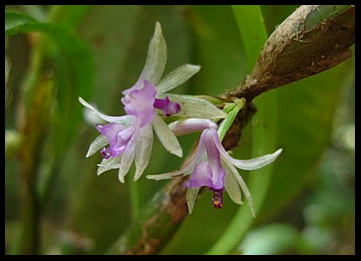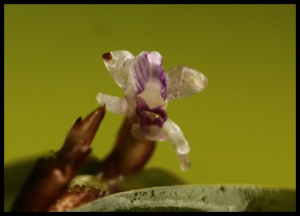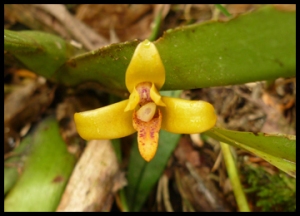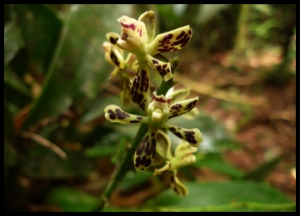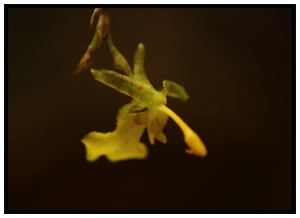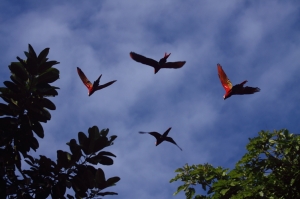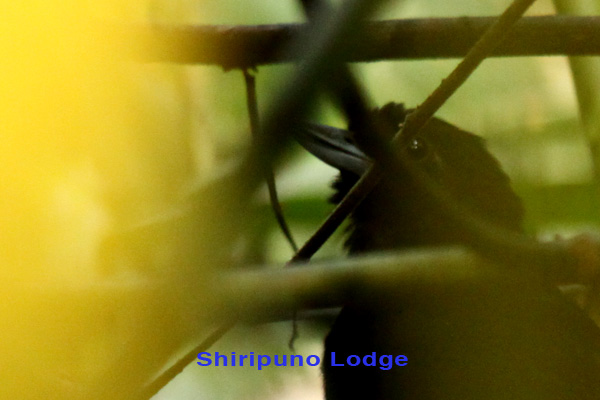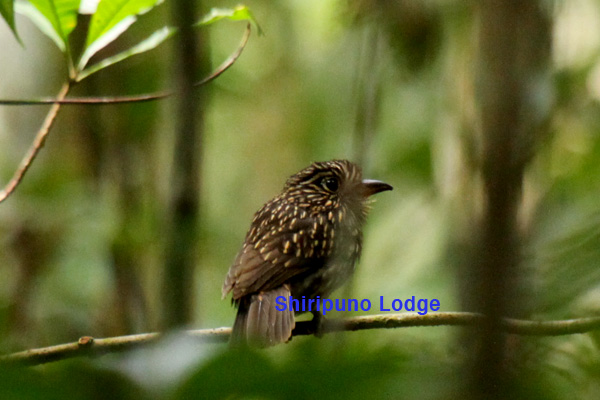Source: Surfbirds
Overview
My son Ian and I have visited Ecuador a number of times and wanted to visit some of the less known areas, spending sufficient time in them to see most of the species present rather than moving on after a couple of days as do many tours. We also had a few specific targets around the Guacamayos and Papallacta areas that we had missed previously. These tactics worked well but generated a smaller total list than you would normally expect on a 15 day Ecuador tour. However, the emphasis was on quality not quantity!
Logistics
We booked flights direct with American Airlines from Heathrow to Quito via Miami. Althoough US immigration in Miami is not a pleasant experience neither are the hassles associated with changing flights in Madrid nowadays! Shripuno Lodge was booked direct with Fernando Vaca shiripuno2004@yahoo.com. All other arrangements were made through Jonas Neilson of Sumaco Lodge jonas@wildsumaco.com. Jonas made all our arrangements for Sumaco, San Isidro and Guango and provided us with a vehicle and driver.
Itinerary
8 February – Flight AA57 from LHR to Miami and onwards on AA967 to Quito arriving Quito 9.40 p.m. Overnight Hotel Sebastian, Quito.
9 February – Tame flight 207 from Quito to Coca at 7.00 a.m. Met Fernando Vaca and drove south for 2 hours to Rio Shiripuno, then motorised canoe for 4.5 hours to Shiripuno Lodge , arriving late afternoon. Overnight Shiripuno Lodge.
10 – 13 February – Shiripuno Lodge
14 February – Return to Coca where met by Jonas Neilson and driver Miguel. Drove to Sumaco Lodge arriving just before dusk.
15 – 18 February – Sumaco Lodge
19 February – Sumaco Lodge early morning, then transfer to Cabanas San Isidro via Guacamayos Ridge. San Isidro Lodge trails in the afternoon. Overnight San Isidro.
20 February – Guacamayos Ridge Trail in the morning and late afternoon with Marcelo. Overnight San Isidro.
21 February – Guacamayos Ridge Trail early morning, then trails at San Isidro late morning. Transfer to Guango Lodge after lunch. Overnight Guango Lodge.
22 February – Papallacta from early morning until early afternoon, then return to Quito. Overnight Hotel Sebastian.
23 February – Flight AA966 from Quito to Miami, then long wait in Miami before catching AA56 to LHR arriving next day at 10.00 a.m.
Main sites visited
Shiripuno Lodge – Accessible only by road then boat from Coca it is situated in the Huaorani Lands and is very isolated in fantastic forest. No electricity or hot water but fantastic food, nice people and great birds. A much better experience than some of the commercial lodges on the Napo.
Sumaco Lodge – situated off the Loreto Road on the slopes of Sumaco volcanoe. Opened in 2008 it is a fantastic lodge with superb accommodation and food, well maintained trails and great birds. A fantastic experience all round and the only place to go in this area with the degradation of the fabelled Loreto Road.
San Isidro Lodge – Well known lodge near Cosanga ideealy placed to bird the Guacamayos Ridge. Brilliant food.
Guango Lodge – Often only used as a coffee stop rather than an overnight stop but ideally placed to be at Papallacta at dawn and better food and ambience than the hotels in Papallacta. The staff are really friendly and helpful.
Guides
Shiripuno Lodge – Fernando Vaca
Sumaco Lodge – Jonas Nilsson
San Isidro/Guacamayos – Marcelo
Daily accounts
8 February – our flight from LHR to Miami proved uneventful, and after negotiating the immigration queues we retrieved our bags and followed the yellow dots to where we had to check them in again and had plenty of time before our connecting flight to Quito. We arrived at Quito at 9.40 pm. And after long wait finally got our bags and met Jonas in Arrivals before taking a taxi to Hotel Sebastian.
9 February – Up early we breakfasted at 5.15 before taking a taxi to the airport for a 6 a.m check-in for our flight to Coca. We met Fernando Vaca of Shiripuno Lodge in the departure lounge and then had a slight problem negotiating with security over the massive battery in Ian’s luggage for his spotlight. We took off on time for Coca but on arrival over Coca were told that Coca Airport was closed and that we would circle until fuel got low and then may have to return to Quito! Luckily the rain storm cleared and we landed in a hot and steamy Coca. We caught a taxi to the Hotel Auca where we took a second breakfast whilst Fernando gathered provisions for our five days at Shiripuno. Eventually we were on our way South in a 4WD for a couple of hours to Shiripuno Bridge. The most notable bird on the journey was Pearl Kite. At Shiripuno Bridge we did a bit of birding whilst the canoe was loaded, paid our $20 each fee to enter Huaorani lands and eventually set off down the Rio Shiripuno at about midday. We gave a few of the locals a ride as far as their settlement about 90 minutes down river but after that saw no other people or boats. For much of the four and a half hour journey the rain hammered down but we soon dried out when it stopped. The Rio Shiripuno had many birds along it-the best being Red-throated Caracara, Blue and Yellow Macaw, Green & Rufous Kingfisher, lots of White-eared Jacamars,Yellow-billed Nunbird, Casqued, Crested and Green Oropendolas. Drab Water-tyrant and Yellow-rumped Cacique were particularly common. We arrived at Shiripuno Lodge late afternoon to be greeted by an immature Black Caracara sitting on the washing line! After briefly depositing our gear in our rooms we set out on the Colibri and Bates Trails which start right by the dining cabin. Considering it was so late in the day we still managed to pick up a number of good birds -Salvin’s Curassow, Fiery Topaz, White-chested Puffbird, Yellow-browed Antbird and Rusty-belted Tapaculo being the pick of them. After a great meal we retired to our rooms serenaded by Nocturnal Curassow and Tawny-bellied Screech Owl. The rooms are very basic, with no windows, only a few scraps of curtains above the lower bamboo walls, no electricity or hot water and it was hard to adjust at first to sleeping 5 metres away from the trees with only a mosquito net to protect you from anything that may be out there! There are no sounds other than the jungle-no generator noise, no boat noise, no other people to disturb you-Shiripuno really is so much more remote than some of the more commercial lodges on the Rio Napo.
10 February – After a fantastic breakfast at 5.15 we were away at dawn on our first full day at Shiripuno. We headed out in the opposite direction to the previous day taking the Wilson, Wallace and Colibri trails. Highlights were a perched Tiny Hawk, Salvin’s Curassow again, Blue-crowned Trogon, brilliant views of a Great Jacamar, Spotted Puffbird, Brown Nunlet, Cinnamon-throated Woodcreeper, Ocellated Woodcreeper, male and female Undulated Antshrike with a nearby pair of Pearly Antshrike, Ringed Antpipit, Yellow-throated Flycatcher, Coraya and Musician Wrens, and Green Oropendola. Ian managed to get views of a Black-throated Hermit that chose not to hang around long enough for me to see it! After lunch we took a short stroll back up the trail to try and re-find the Hermit but had no success but did find a pair of Golden-collared Toucanets. The afternoon was much quieter and we cruised up the river to the La Laguna trail and tried , unsuccessfully, to find White-lored Antpitta but did find Golden-green Woodpecker.
11 February – We were in the canoe at dawn heading up the river to the Mirador trail. Our first target was Ochre-striped Antpitta and we soon found one calling but despite spending an hour or so trying to see it we failed miserably. At times it could have only been a few feet away but remained hidden. As we climbed up the trail to the Mirador Ian spotted a Cinnamon Neopipo right next to the track which gave excellent views before we moved on. Black-tailed and Black-throated Trogons were also seen and on the way back down the trail Fernando spotted a movement in the trees above us and after a bit of searching we got magnificent views of a Black-faced Hawk. Lunchtime today produced Olive-faced Flatbill and White-browed Purpletuft around the lodge clearing. In the afternoon we set off down river to the Mysterioso trail,. The afternoon again proved quiet but Black Antbird, Black-faced Antthrush, Dusky-chested Flycatcher a Chestnut-headed Crake that actually showed itself made the effort worthwhile. In the evening we set off determined to track down one of the Calling Nocturnal Curassows and after a long walk through the jungle we got very close before having to put our lights on to cross a stream and, predictably, the bird then stopped calling and we could not locate it.
12 February – This morning we took the canoe down river to the Skutch Trail and came back via the Mysterioso and Colibri Trails to the lodge for lunch. Bird of the morning was a Slaty-backed Forest-falcon that gave incredible views running along branches above our heads! Grey-winged Trumpeters called tantalisingly close but refused to show as did a number of Lawrence’s Thrushes. Yellow-throated Woodpecker, Ash-throated Gnatcatcher, Cinereous Mourner, Western-striped Manakin and Rusty-belted Tapaculo were more obliging. Just before we got back to the Lodge we found a small ant swarm with Southern Nightingale-wren, Black-faced Antbird and Spot-winged Antbird in attendance. After a quick lunch we decided to go back and check out this spot again and were rewarded with Yasuni Antwren, White-plumed Antbird, Bicoloured Antbird, Scale-backed Antbird and Lunulated Antbird! Two Southern Nightingale-wrens, normally real skulkers, ran around on the path in front of us. It was difficult to tear ourselves away from this but we headed out on the Wilson, Bates and Orchidea trails for the afternoon finding the trails to be much quieter in the afternoon as we had on the previous days. After the previous days experience we decided to get to the Nocturnal Curassow spot before dark and wait quietly until it started calling. It was soon pitch black and you could not see two feet in front of you in our spot under the trees. The quiet was suddenly broken by a cry from Ian that something had stung him, we put the lights on quickly to discover that a Bullet Ant (Conga) had dropped from the trees and stung him on the back and it then got him again on the hand before he shook it off. With all this commotion there was no hope of getting the Curassow but on hearing one in the distance, Ian insisted that we try for it despite his pain. Needless to say we didn’t see it!
13 February – Feeling somewhat shattered after our efforts of the last few days and the problems of the previous night we set off on the Mysterioso trail in a rather subdued manner this morning. Our spirits lifted when we finally nailed a Ringed Woodpecker-a bird we had been looking for over a few days and they lifted even further when Fernando heard a call from the other side of the river and hacked a trail for us with the machete. We couldn’t imagine what bird would put up with all this noise but suddenly we were watching a singing Black Bushbird and a Pale-tailed Barbthroat put in an appearance as well. We tried again ,at a different site this time, for White-lored Antpitta and this time enjoyed prolonged views of a bird singing! Rio Suno Antwren was also found together with Spot-backed and Sooty Antbirds. Needless to say-we made no attempt for the Nocturnal Curassow this evening!
14 February – Today was to be a travel day with the long journey back to Coca and the onward transfer to Sumaco so we only had a short time for birding before leaving. First highlight of the day was a Rufous Potoo that almost flew into us before retreating back in to the twilight of dawn! We ate breakfast, packed the canoe and set off for Coca and a short way up the river came across a startled Tapir out for an early morning swim! I am not sure who was most surprised but we got a fantastic view of the animal swimming very close to us before it scrambled up the bank and disappeared into the jungle. There were many birds along the river, the highlights being Grey-necked Wood-rail, Sunbittern, Hook-billed Kite and Amazonian Streaked-antwren. It took four and half hours to get back to Shiripuno Bridge, at one stage a log jam had to be cleared with a chain saw for us to make progress before we finally got to the landing stage and were met by a driver in a 4WD who took us to Coca. Coca was very hot and it was Carnival day with all the locals trying to douse you with water or foam so we took refuge in the Hotel Auca until Jonas and his driver Miguel arrived to take us to Sumaco. We negotiated the various carnival day’s drunks lying in the road here and there and arrived at Sumaco late afternoon. We made a couple of stops on the entrance road and saw our first Olive-sided Flycatcher of the trip before visiting the hummingbird feeders near the Residence buildings. Green Hermit, Grey-chinned Hermit, Napo Sabrewing, Violet-headed Hummingbird, Golden-tailed Sapphire, Many-spotted Hummingbird, Ecuadorian Piedtail and Black-throated Brilliant were all present in a late afternoon feeding frenzy. We had stayed at Sumaco for one night in 2008 just after it opened and had always wanted to return and it was sheer heaven to have hot water showers and electricity again before celebrating with a good bottle of wine over dinner.
15 February – We took breakfast before dawn and headed out to the Residencia area again before taking the Piha and Waterfall trails. Jonas had only a week ago had a gall-bladder operation but insisted on guiding us for the morning and he gave us a superb mornings birding at that! During the day we had well over 150 species seen and heard and Jonas superb knowledge of calls was evident at all times. After a quick check of the feeders we headed down the Piha trail with the first bird being an elusive Black-billed Treehunter and then spent time looking for Yellow-throated Spadebill before finding one sitting obligingly on a bare branch. Birds came thick and fast in the forest with the highlights being Gilded and Red-headed Barbet, White-shouldered Antshrike, Foothill Antwren, Yellow-breasted Antwren, Blue-rumped Manakin, Plain-winged Antwren, Foothill Elaenia, Buff-throated Tody-tyrant, Ecuadorian Tyrannulet, Rufous-naped Greenlet, singing Olive Finch, White-tipped sicklebill perched by the trail, Scarlet-breasted Fruiteater and as we got back to the road, a Blue-browed Tanager. An immature male Rufous-vented Whitetip caused some identification problems for a while. We set off again walking along the road to the F.A.C.E trail in the late afternoon. Olive-chested Flycatcher and Scaled Pigeon were seen along the road and the trail gave us fantastic views of a pair of Rufous-breasted Piculets and a Sulphur-bellied Tyrannulet got Jonas excited as it was a new addition to the Sumaco list. Spotted Nightingale-thrushes were heard a number of times but refused to show themselves.
16 February – This morning we headed for the F.A.C.E trail which is just a short walk down the road from the lodge. More than one Buckley’s Forest Falcon was calling nearby as we left the lodge but none could be found. This morning was much quieter than the previous morning but Foothill Antwren, Spot-backed Antbird, Chestnut-crowned Gnateater, Yellow-cheeked Becard and a pair of White-streaked Antvireos kept us on our toes. Heading back for lunch we tried a spot a little down the track from the main lodge and found a Red-billed Tyrannulet singing for us. Our leisurely lunch was interrupted by an immature Black & Chestnut Eagle soaring over the lodge before we set out for the Manakin trail for the afternoon. Our prime target was soon seen when Daniel coaxed a Northern White-crowned Tapaculo on to the path in front of us-unfortunately the calling Wing-banded wren would not do the same and continued to elude us. A Goulds Jewelfront was on the feeders near the residence buildings . After our evening meal we headed out to try for Foothill Screech-owl but only heard one distantly.
February 17 – This morning we headed for Puffbird, Piha and Waterfall trails after again being defeated by the calling Buckley’s Forest-falcons! We had lots of good birds this morning with Rufous-breasted Wood-quail and chicks, Coppery-chested Jacamar, Ornate Antwren, White-backed Fire-eye, brilliant views of Short-tailed Antthrush, Grey-tailed Piha (after a lot of searching) and Ochre-breasted Antpitta the highlights.
Mid afternoon we set out on the Benavides trail for the first time and then tried F.A.C.E. again. Two Rufous-breasted Antthrushes at point blank range were the best birds before we set out again in the evening to try and track down Foothill Screech-owl. This evening we got to with 10-20 metres of one before it melted into the night once again leaving us frustrated!
February 18 – Today was to be our last day at Sumaco and we headed to the Residencia area followed by Piha and Waterfall trails again. Starting on the main track by the garage a Black & White Tody-flycatcher proved hard to get before finally revealing itself and a pair of Dusky Spinetails gave great views near the Residence , a displaying Grey-chinned Hermit was fascinating to watch ,and three Ornate Antwrens were in the same area. On the trails Rufous-rumped Antwren was seen after being heard on the previous day, two Short-tailed Antthrushes showed well, a male Fiery-throated Fruiteater shone in the treetops and a Fulvous Shrike-tanager was seen perched on a branch at head height before we headed back for lunch. F.A.C.E. trail was the venue for the afternoon in the hope of finally enticing a Spotted Nightingale-thrush to show itself-sadly this didn’t happen although at least two were calling. Two Military Macaws flew over, two or three Lemon-browed Flycatchers showed well, a Black-billed Treehunter showed intermittently , a male Scarlet-breasted Fruiteater gave stunning close-up views and a couple of White-winged Tanagers were the first of the trip. In the evening Jonas decided to show us the proper way to see a Foothill Screech-owl! We set off armed with a machete and walked much further in to the vegetation than on previous nights until eventually we could hear it calling close by, a shape then flew over us and began calling behind us, we did our best to track it down in the vegetation but in the end it seemed to be calling from just in front of us and as Jonas ducked under some low branches it flew from less than six feet in front of him never to be seen again!! To compound it all it now started raining and the Rufescent Screech-owl that had been calling from up the road now fell silent! Oh well-we’ll have to come back won’t we?
February 19 – We loaded up the 4WD after an early breakfast to try and track down the Black & White Tody-flycatcher for Ian by the garage. The bird was calling a lot but only gave fleeting glimpses before we had to leave for San Isidro with our driver Miguel. Jonas came along in another car also as he was returning to Quito to see his doctor. The Loreto Road seemed a different place to the road I had driven five years ago with so much development and consequent destruction of habitat. A quick stop at a known site for Orange-breasted Falcon proved fruitless-apparently they are more reliable in the afternoon. As we ascended the Guacamayos ridge we made two or three profitable stops-at one stop we had good views of a couple of Andean Solitaires and then a pair of Black-streaked Puffbirds posing not far from the road (a bird we had searched Sumaco for!) and then when Jonas spotted a flock from the car in Sector Cocodrillo we stopped and found a fantastic flock containing male and female Black-chested Fruiteater, Rufous-crested Tanager, Blue-winged Mountain-tanager, Golden-eared tanager, Saffron-crowned tanager, Golden-naped Tanager, three Blue-browed Tanagers and Black-capped Tanagers. Elated with this we pressed on to the pass and stopped by the shrine where we got Common Bush-tanager, Yellow-throated Bush-tanager and Ashy-throated Bush-tanager. Jonas now left us to continue his journey to Quito whilst we continued to San Isidro with Miguel ,seeing five Torrent Ducks from the bridge at Cosanga. We had the afternoon to ourselves at San Isidro and walked the Antvireo trail and then the Yanayacu Road. As always, San Isidro was very birdy and we picked up the usual suspects such as masked Trogon, Pale-edged Flycatcher, Andean Toucanet, Ornate Flycatcher and a few of the more unusual birds such as Bronze-olive Pygmy-tyrant and Rufous-crowned Tody-tyrant. A Blackpoll Warbler by the car park was apparently a scarce bird for San Isidro. During our evening meal our guide for the next day, Marcelo, introduced himself to us and didn’t seem too perturbed by the list of targets we gave him for the next day! A trip to the Guacamayos shrine after dinner produced only a brief view of Rufous-banded Owl as the ridge was shrouded in thick fog.
February 20 – Miguel drove ourselves and Marcelo up to the Shrine at dawn and when we arrived it was very murky and misty making viewing difficult. At first things were quiet in the mist with only a few Grass-green Tanagers, Black-eared and Black-capped Hemispingus on view but then we hit a purple patch with superb views of Slate-crowned Antpitta, a Barred Antthrush almost under our feet , brilliant views of Long-tailed Tapaculo and then a totally unexpected White-faced Nunbird ! Ian got brief views of a Yellow-vented Woodpecker but it didn’t hang around for me! Elated with this we headed back to San Isidro for lunch only to find seven White-capped Tanagers next to the road just before Cosanga. After lunch Ian and I wandered around the cabins seeing Crimson-mantled Woodpecker, Black-billed Peppershrike and a Chestnut-crowned Antpitta disappearing under our cabin. We had another go at the Antvireo trail and this time came up trumps with a male Bicoloured Antvireo about 150 metres past the bridge. We met Marcelo again later and decided to drive back up to the ridge to try for a few things that we had missed after seeing Golden-headed Quetzal and Highland Motmot in the now heavy rain. As we drove upwards the rain and mist got heavier and heavier until we could hardly see 5 metres and it continued for a long way as we drove down slope. Finally driving out of the rain we saw very little before heading back up to the shrine where it had now stopped raining. The trail was quiet now in the hour before dusk but Marcelo came up trumps when he pointed out a roosting Andean Potoo much to Ian’s delight.
February 21 – We were on our own again today so we got Miguel to take us back to the shrine after breakfast and we walked the Ridge Trail again for a short while picking up Andean Guan, the Andean Potoo once more, Green & Black Fruiteater, two juvenile Plushcaps and two obliging Plain-tailed Wrens. A short drive down slope gave us the desired Black-billed Mountain-toucan that we had been hearing. A short walk on the trails by the lodge also gave another of our targets-Chestnut-breasted Chlorophonia before we had lunch and set off for Guango Lodge. We reached Guango mid-afternoon and spent our time on the trails near the lodge and by the river adding Fawn-breasted Brilliant, Glowing Puffleg, Buff-tailed Coronet, Buff-winged Starfrontlet, Sword-billed Hummingbird, Great Sapphirewing, Long-tailed sylph, Grey-breasted Mountain-toucan, Capped Conebill, Scarlet-bellied Mountain-tanager, Slaty Brushfinch and Chestnut-capped Brushfinch. We had a great meal in front of a log fire and wondered why we had never stayed at Guango before!
February 22 – Up early so as to be at Papallacta as early as possible we headed for the dirt road behind the thermal pools and negotiated our way past the guard. We had visited Papallacta a few times before and so had a few select targets here. We drove slowly up the valley and all seemed quiet so when we got to the guard house at the top we got out and slowly walked back down the road before finding the flock we were looking for- it contained at least twenty Black-backed Bush-tanagers, two Pale-naped Brush-finches, three Masked Mountain-tanagers, a few Blue-winged Mountain-tanagers and two Blue-backed Conebills. We watched these until they disappeared down the hillside and then found a couple of Paramo Seedeaters in the trackside bushes. Happy with this we walked further down and inched our way in to a bamboo patch, where, after a tense wait we got close-up views of a Crescent-faced Antpitta we had heard calling earlier. Next stop was Sendero Arriero where we saw Andean Coot, Andean Ruddy Duck, Yellow-billed Pintail and Andean Teal on the lake but a calling Paramo Tapaculo remained invisible. Next we carried on up to the pass and decided to concentrate all our efforts on Paramo Tapaculo as we had no other targets left. We walked slowly down the old road towards Quito until we heard one and then after crouching down in a roadside bush eventually one hopped around at our feet! Happy with this we headed back to Quito and the Hotel Sebastian for the night.
February 23 – Up early again for the 9.40 American Airlines flight to Miami we were put on an earlier flight that was running late and arrived in Miami with seven hours to wait. At least two hours was taken up with the ever popular immigration procedures before we wasted hours touring the airport restaurants looking for one that could cope with one Gluten Free and one Vegetarian without much success so we settled down to tot up our list. 504 species seen-it could have been higher if we had moved around more but we had specific targets and also wanted to spend plenty of time at Shiripuno and Sumaco rather than move on so we were very happy with the results.
February 24 – On time arrival at Heathrow and our baggage arrived as well!
Species Lists
(seen only, no heard only listed)
Great Tinamou [peruvianus] Tinamus major peruvianus
Undulated Tinamou [yapura] Crypturellus undulatus yapura
Anhinga [anhinga] Anhinga anhinga anhinga
Little Blue Heron Egretta caerulea
Western Cattle Egret Bubulcus ibis ibis
Striated Heron [striata] Butorides striata striata
Boat-billed Heron [cochlearius] Cochlearius cochlearius cochlearius
Turkey Vulture [sp] Cathartes aura
Greater Yellow-headed Vulture Cathartes melambrotus
Black Vulture [sp] Coragyps atratus
King Vulture Sarcoramphus papa
Colombian Torrent Duck Merganetta armata colombiana
Andean Teal Anas andium andium
Yellow-billed Pintail [sp] Anas georgica
Andean Duck Oxyura jamaicensis ferruginea
Hook-billed Kite [uncinatus] Chondrohierax uncinatus uncinatus
Swallow-tailed Kite [sp] Elanoides forficatus
Pearl Kite [magnus] Gampsonyx swainsonii magnus
Double-toothed Kite [bidentatus] Harpagus bidentatus bidentatus
Plumbeous Kite Ictinia plumbea
Tiny Hawk [superciliosus] Accipiter superciliosus superciliosus
Black-faced Hawk Leucopternis melanops
Roadside Hawk [magnirostris] Buteo magnirostris magnirostris
Broad-winged Hawk [sp] Buteo platypterus
Red-backed Hawk Buteo polyosoma polyosoma
Black-and-chestnut Eagle Spizaetus isidori
Black Caracara Daptrius ater
Red-throated Caracara Ibycter americanus
Yellow-headed Caracara Milvago chimachima
Laughing Falcon [cachinnans] Herpetotheres cachinnans cachinnans
Slaty-backed Forest Falcon Micrastur mirandollei
Bat Falcon [rufigularis] Falco rufigularis rufigularis
Speckled Chachalaca Ortalis guttata
Andean Guan [brooki] Penelope montagnii brooki
Spix’s Guan [jacquacu] Penelope jacquacu jacquacu
Blue-throated Piping-guan [sp] Pipile cumanensis
Sickle-winged Guan [tschudii] Chamaepetes goudotii tschudii
Salvin’s Curassow Mitu salvini
Marbled Wood Quail [buckleyi] Odontophorus gujanensis buckleyi
Rufous-breasted Wood Quail [soderstromii] Odontophorus speciosus soderstromii
Hoatzin Opisthocomus hoazin
Chestnut-headed Crake [castaneiceps] Anurolimnas castaneiceps castaneiceps
Grey-necked Wood Rail [cajanea] Aramides cajanea cajanea
Slate-coloured Coot [atrura] Fulica ardesiaca atrura
Sunbittern [helias] Eurypyga helias helias
Spotted Sandpiper Actitis macularius
Feral Pigeon Columba livia ‘feral’
Scaled Pigeon Patagioenas speciosa
Pale-vented Pigeon Patagioenas cayennensis
White-naped (Band-tailed) Pigeon Patagioenas fasciata albilinea
Plumbeous Pigeon [delicata] Patagioenas plumbea delicata
Ruddy Pigeon [berlepschi] Patagioenas subvinacea berlepschi
Eared Dove [hypoleuca] Zenaida auriculata hypoleuca
Ruddy Ground-dove Columbina talpacoti
Grey-fronted Dove [dubusi] Leptotila rufaxilla dubusi
Ruddy Quail-dove [montana] Geotrygon montana montana
Blue-and-yellow Macaw Ara ararauna
Military Macaw [militaris] Ara militaris militaris
Scarlet Macaw [macao] Ara macao macao
Chestnut-fronted Macaw Ara severus
Red-bellied Macaw Orthopsittaca manilata
Dusky-headed Parakeet Aratinga weddellii
Maroon-tailed Parakeet [melanura] Pyrrhura melanura melanura
Cobalt-winged Parakeet [cyanoptera] Brotogeris cyanoptera cyanoptera
Black-headed Parrot [pallidus] Pionites melanocephalus pallidus
Blue-headed Parrot [menstruus] Pionus menstruus menstruus
Red-billed Parrot [corallinus] Pionus sordidus corallinus
White-capped Parrot Pionus tumultuosus seniloides
Orange-winged Parrot Amazona amazonica
Mealy Parrot [farinosa] Amazona farinosa farinosa
Squirrel Cuckoo [mesura] Piaya cayana mesura
Black-bellied Cuckoo Piaya melanogaster
Greater Ani Crotophaga major
Smooth-billed Ani Crotophaga ani
Rufous-banded Owl Ciccaba albitarsis
Spectacled Owl [perspicillata] Pulsatrix perspicillata perspicillata
Great Potoo [grandis] Nyctibius grandis grandis
Andean Potoo Nyctibius maculosus
Rufous Potoo Nyctibius bracteatus
Pauraque [albicollis] Nyctidromus albicollis albicollis
Chestnut-collared Swift [sp] Streptoprocne rutila
White-collared Swift [sp] Streptoprocne zonaris
Grey-rumped Swift [sp] Chaetura cinereiventris
Short-tailed Swift [brachyura] Chaetura brachyura brachyura
Fork-tailed Palm Swift [semota] Tachornis squamata semota
White-tipped Sicklebill [sp] Eutoxeres aquila
Pale-tailed Barbthroat [cervinicauda] Threnetes leucurus cervinicauda
White-bearded Hermit Phaethornis hispidus
Green Hermit [apicalis] Phaethornis guy apicalis
Tawny-bellied Hermit Phaethornis syrmatophorus
Straight-billed Hermit Phaethornis bourcieri
Black-throated Hermit Phaethornis atrimentalis
Grey-chinned Hermit [griseogularis] Phaethornis griseogularis griseogularis
Blue-fronted Lancebill [johannae] Doryfera johannae johannae
Grey-breasted Sabrewing [aequatorialis] Campylopterus largipennis aequatorialis
Napo Sabrewing Campylopterus villaviscensio
Sparkling Violetear [coruscans] Colibri coruscans coruscans
Black-throated Mango Anthracothorax nigricollis
Fiery Topaz [sp] Topaza pyra
Violet-headed Hummingbird [guimeti] Klais guimeti guimeti
Fork-tailed Woodnymph [viridipectus] Thalurania furcata viridipectus
Golden-tailed Sapphire [oenone] Chrysuronia oenone oenone
Many-spotted Hummingbird Taphrospilus hypostictus
Speckled Hummingbird [sp] Adelomyia melanogenys
Ecuadorian Piedtail Phlogophilus hemileucurus
Gould’s Jewelfront Heliodoxa aurescens
Fawn-breasted Brilliant [cervinigularis] Heliodoxa rubinoides cervinigularis
Black-throated Brilliant [schreibersii] Heliodoxa schreibersii schreibersii
Chestnut-breasted Coronet Boissonneaua matthewsii
Buff-tailed Coronet Boissonneaua flavescens
Shining Sunbeam [cupripennis] Aglaeactis cupripennis cupripennis
Mountain Velvetbreast [saul] Lafresnaya lafresnayi saul
Bronzy Inca [obscura] Coeligena coeligena obscura
Collared Inca [torquata] Coeligena torquata torquata
Buff-winged Starfrontlet Coeligena lutetiae
Sword-billed Hummingbird Ensifera ensifera
Great Sapphirewing [peruvianus] Pterophanes cyanopterus peruvianus
Tourmaline Sunangel Heliangelus exortis
Glowing Puffleg [sp] Eriocnemis vestita
Rufous-vented Whitetip Urosticte ruficrissa
Buff-booted Racket-tail [peruanus] Ocreatus underwoodii peruanus
Tyrian Metaltail [tyrianthina] Metallura tyrianthina tyrianthina
Rainbow-bearded Thornbill [herrani] Chalcostigma herrani herrani
Long-tailed Sylph [mocoa] Aglaiocercus kingi mocoa
White-bellied Woodstar Chaetocercus mulsant
Green-backed Trogon Trogon viridis
Collared Trogon [collaris] Trogon collaris collaris
Masked Trogon [personatus] Trogon personatus personatus
Black-throated Trogon [sulphureus] Trogon rufus sulphureus
Blue-crowned Trogon [peruvianus] Trogon curucui peruvianus
Black-tailed Trogon [eumorphus] Trogon melanurus eumorphus
Golden-headed Quetzal [auriceps] Pharomachrus auriceps auriceps
Green-and-rufous Kingfisher Chloroceryle inda
Green Kingfisher [americana] Chloroceryle americana americana
Amazon Kingfisher Chloroceryle amazona
Ringed Kingfisher [torquata] Megaceryle torquata torquata
Plain-tailed Motmot [pyrrholaemum] Electron platyrhynchum pyrrholaemum
Highland Motmot [aequatorialis] Momotus momota aequatorialis
White-eared Jacamar Galbalcyrhynchus leucotis
Yellow-billed Jacamar [chalcocephala] Galbula albirostris chalcocephala
Coppery-chested Jacamar Galbula pastazae
Great Jacamar [isidori] Jacamerops aureus isidori
White-necked Puffbird [hyperrynchus] Notharchus hyperrhynchus hyperrhynchus
Spotted Puffbird [pulmentum] Bucco tamatia pulmentum
White-chested Puffbird Malacoptila fusca
Black-streaked Puffbird Malacoptila fulvogularis
Brown Nunlet Nonnula brunnea
White-faced Nunbird Hapaloptila castanea
Black-fronted Nunbird [nigrifrons] Monasa nigrifrons nigrifrons
White-fronted Nunbird [peruana] Monasa morphoeus peruana
Yellow-billed Nunbird Monasa flavirostris
Swallow-winged Puffbird [tenebrosa] Chelidoptera tenebrosa tenebrosa
Scarlet-crowned Barbet Capito aurovirens
Gilded Barbet [punctatus] Capito auratus punctatus
Lemon-throated Barbet [richardsoni] Eubucco richardsoni richardsoni
Red-headed Barbet [orientalis] Eubucco bourcierii orientalis
Andean Toucanet [albivitta] Aulacorhynchus prasinus albivitta
Chestnut-tipped Toucanet [derbianus] Aulacorhynchus derbianus derbianus
Golden-collared Toucanet Selenidera reinwardtii reinwardtii
Grey-breasted Mountain Toucan [sp] Andigena hypoglauca
Black-billed Mountain Toucan [spilorhynchus] Andigena nigrirostris spilorhynchus
Lettered Aracari [humboldti] Pteroglossus inscriptus humboldti
Chestnut-eared Aracari [castanotis] Pteroglossus castanotis castanotis
Many-banded Aracari Pteroglossus pluricinctus
Ivory-billed Aracari [flavirostris] Pteroglossus azara flavirostris
Yellow-ridged Toucan Ramphastos vitellinus culminatus
Cuvier’s Toucan Ramphastos tucanus cuvieri
Black-mandibled Toucan [ambiguus] Ramphastos ambiguus ambiguus
Lafresnaye’s Piculet [lafresnayi] Picumnus lafresnayi lafresnayi
Rufous-breasted Piculet [rufiventris] Picumnus rufiventris rufiventris
Yellow-tufted Woodpecker Melanerpes cruentatus
Yellow-vented Woodpecker Veniliornis dignus
Smoky-brown Woodpecker [fumigatus] Picoides fumigatus fumigatus
Little Woodpecker [agilis] Veniliornis passerinus agilis
Red-stained Woodpecker [hilaris] Veniliornis affinis hilaris
Yellow-throated Woodpecker [sp] Piculus flavigula
Golden-green Woodpecker [sp] Piculus chrysochloros
Crimson-mantled Woodpecker [brevirostris] Colaptes rivolii brevirostris
Golden-olive Woodpecker [buenavistae] Colaptes rubiginosus buenavistae
Scaly-breasted Woodpecker [verreauxii] Celeus grammicus verreauxii
Chestnut-crested Woodpecker [citreopygius] Celeus elegans citreopygius
Ringed Woodpecker [occidentalis] Celeus torquatus occidentalis
Lineated Woodpecker [sp] Dryocopus lineatus
Crimson-crested Woodpecker [melanoleucos] Campephilus melanoleucos melanoleucos
Bar-winged Cinclodes [albidiventris] Cinclodes fuscus albidiventris
Elegant Spinetail [media] Synallaxis azarae media
Dark-breasted Spinetail [albigularis] Synallaxis albigularis albigularis
Brown-tailed Spinetail Synallaxis moesta brunneicaudalis
Ash-browed Spinetail Cranioleuca curtata
Spotted Barbtail [brunnescens] Premnoplex brunnescens brunnescens
Pearled Treerunner [perlatus] Margarornis squamiger perlatus
Streaked Tuftedcheek [oberholseri] Pseudocolaptes boissonneautii oberholseri
Montane Foliage-gleaner [montana] Anabacerthia striaticollis montana
Striped Woodhaunter Hyloctistes subulatus
Rufous-tailed Foliage-gleaner [subflavescens] Philydor ruficaudatum subflavescens
Chestnut-winged Foliage-gleaner [erythropterum] Philydor erythropterum erythropterum
Black-billed Treehunter [melanorhynchus] Thripadectes melanorhynchus melanorhynchus
Olive-backed Foliage-gleaner [infuscatus] Automolus infuscatus infuscatus
Chestnut-crowned Foliage-gleaner [consobrinus] Automolus rufipileatus consobrinus
Slender-billed Xenops [acutirostris] Xenops tenuirostris acutirostris
Plain Xenops [obsoletus] Xenops minutus obsoletus
Streaked Xenops Xenops rutilans
Tyrannine Woodcreeper [tyrannina] Dendrocincla tyrannina tyrannina
Plain-brown Woodcreeper [neglecta] Dendrocincla fuliginosa neglecta
Olivaceous Woodcreeper [amazonus] Sittasomus griseicapillus amazonus
Wedge-billed Woodcreeper [castelnaudii] Glyphorynchus spirurus castelnaudii
Cinnamon-throated Woodcreeper [devillei] Dendrexetastes rufigula devillei
Strong-billed Woodcreeper Xiphocolaptes promeropirhynchus
Amazonian Barred Woodcreeper [radiolatus] Dendrocolaptes certhia radiolatus
Tschudi’s Woodcreeper [napensis] Xiphorhynchus ocellatus napensis
Spix’s Woodcreeper Xiphorhynchus spixii
Striped Woodcreeper [palliatus] Xiphorhynchus obsoletus palliatus
Lafresnaye’s Woodcreeper [guttatoides] Xiphorhynchus guttatus guttatoides
Olive-backed Woodcreeper [triangularis] Xiphorhynchus triangularis triangularis
Straight-billed Woodcreeper [peruvianus] Dendroplex picus peruvianus
Montane Woodcreeper [aequatorialis] Lepidocolaptes lacrymiger aequatorialis
Red-billed Scythebill [napensis] Campylorhamphus trochilirostris napensis
Undulated Antshrike [fulva] Frederickena unduligera fulva
Great Antshrike [melanurus] Taraba major melanurus
Lined Antshrike [tenuifasciatus] Thamnophilus tenuepunctatus tenuifasciatus
White-shouldered Antshrike [aethiops] Thamnophilus aethiops aethiops
Plain-winged Antshrike [capitalis] Thamnophilus schistaceus capitalis
Spot-winged Antshrike [stellaris] Pygiptila stellaris stellaris
Black Bushbird Neoctantes niger
Pearly Antshrike Megastictus margaritatus
Peruvian Antshrike [aequatorialis] Thamnistes anabatinus aequatorialis
Plain Antvireo [napensis] Dysithamnus mentalis napensis
White-streaked Antvireo Dysithamnus plumbeus leucostictus
Bicolored Antvireo [punctitectus] Dysithamnus occidentalis punctitectus
Cinereous Antshrike [glaucus] Thamnomanes caesius glaucus
Brown-backed Antwren Epinecrophylla fjeldsaai
Foothill Antwren [spodionota] Epinecrophylla spodionota spodionota
Chestnut-saddled Antwren [saturata] Epinecrophylla ornata saturata
Rufous-tailed Antwren [erythrura] Epinecrophylla erythrura erythrura
Pygmy Antwren Myrmotherula brachyura
Short-billed Antwren Myrmotherula ignota obscura
Amazonian Streaked Antwren Myrmotherula multostriata
Plain-throated Antwren [suffusa] Myrmotherula hauxwelli suffusa
White-flanked Antwren [melaena] Myrmotherula axillaris melaena
Slaty Antwren [interior] Myrmotherula schisticolor interior
Rio Suno Antwren [sunensis] Myrmotherula sunensis sunensis
Plain-winged Antwren [behni] Myrmotherula behni behni
Long-winged Antwren [zimmeri] Myrmotherula longipennis zimmeri
Grey Antwren Myrmotherula menetriesii
Yellow-breasted Antwren [aequatorialis] Herpsilochmus axillaris aequatorialis
Rufous-rumped Antwren [callinota] Terenura callinota callinota
Blackish Antbird [aequatorialis] Cercomacra nigrescens aequatorialis
Black Antbird Cercomacra serva
White-backed Fire-eye [castanoptera] Pyriglena leuconota castanoptera
Black-faced Antbird [elegans] Myrmoborus myotherinus elegans
Peruvian Warbling Antbird [saturata] Hypocnemis peruviana saturata
Yellow-browed Antbird [hypoxantha] Hypocnemis hypoxantha hypoxantha
Spot-winged Antbird [subplumbea] Schistocichla leucostigma subplumbea
White-shouldered Antbird Myrmeciza melanoceps
Sooty Antbird [sp] Myrmeciza fortis
Spot-backed Antbird [theresae] Hylophylax naevius theresae
Scale-backed Antbird [lepidonota] Willisornis poecilinotus lepidonota
White-faced Antbird [peruvianus] Pithys albifrons peruvianus
White-cheeked Antbird [castaneus] Gymnopithys leucaspis castaneus
Lunulated Antbird Gymnopithys lunulatus
Black-faced Antthrush [zamorae] Formicarius analis zamorae
Rufous-breasted Antthrush [thoracicus] Formicarius rufipectus thoracicus
Short-tailed Antthrush [punctigula] Chamaeza campanisona punctigula
Barred Antthrush [mollissima] Chamaeza mollissima mollissima
Plain-backed Antpitta Grallaria haplonota
Tawny Antpitta [quitensis] Grallaria quitensis quitensis
Chestnut-crowned Antpitta [ruficapilla] Grallaria ruficapilla ruficapilla
White-lored Antpitta [fulviventris] Hylopezus fulviventris fulviventris
Ochre-breasted Antpitta [flavirostris] Grallaricula flavirostris flavirostris
Slate-crowned Antpitta [nana] Grallaricula nana nana
Crescent-faced Antpitta Grallaricula lineifrons
Ash-throated Gnateater Conopophaga peruviana
Chestnut-crowned Gnateater [castaneiceps] Conopophaga castaneiceps castaneiceps
Rusty-belted Tapaculo [erithacus] Liosceles thoracicus erithacus
White-crowned Tapaculo Scytalopus atratus atratus
Long-tailed Tapaculo Scytalopus micropterus
Paramo Tapaculo [opacus] Scytalopus canus opacus
Green-and-black Fruiteater [confusa] Pipreola riefferii confusa
Black-chested Fruiteater Pipreola lubomirskii
Bluish-crowned Fruiteater Pipreola frontalis squamipectus
Fiery-throated Fruiteater Pipreola chlorolepidota
Grey-tailed Piha Snowornis subalaris
Screaming Piha Lipaugus vociferans
Plum-throated Cotinga Cotinga maynana
Spangled Cotinga Cotinga cayana
Bare-necked Fruitcrow Gymnoderus foetidus
Andean Cock-of-the-Rock Rupicola peruviana
White-crowned Manakin [coracina] Pipra pipra coracina
Golden-headed Manakin [berlepschi] Pipra erythrocephala berlepschi
Blue-crowned Manakin [coronata] Lepidothrix coronata coronata
Blue-rumped Manakin [isidorei] Lepidothrix isidorei isidorei
White-bearded Manakin [interior] Manacus manacus interior
Western Striped Manakin [striolatus] Machaeropterus regulus striolatus
Dwarf Tyrant-manakin Tyranneutes stolzmanni
Black-crowned Tityra [buckleyi] Tityra inquisitor buckleyi
Black-tailed Tityra [cayana] Tityra cayana cayana
Masked Tityra [fortis] Tityra semifasciata fortis
Thrush-like Mourner [aenea] Schiffornis turdina aenea
Cinereous Mourner Laniocera hypopyrra
White-browed Purpletuft [isabellae] Iodopleura isabellae isabellae
Yellow-cheeked Becard [xanthogenys] Pachyramphus viridis xanthogenys
Barred Becard [versicolor] Pachyramphus versicolor versicolor
White-winged Becard [tenebrosus] Pachyramphus polychopterus tenebrosus
Black-and-white Becard [salvini] Pachyramphus albogriseus salvini
Sooty-headed Tyrannulet Phyllomyias griseiceps
Ashy-headed Tyrannulet Phyllomyias cinereiceps
Foothill Elaenia Myiopagis olallai
White-crested Elaenia [griseigularis] Elaenia albiceps griseigularis
White-tailed Tyrannulet Mecocerculus poecilocercus
White-banded Tyrannulet [sp] Mecocerculus stictopterus
White-throated Tyrannulet [rufomarginatis] Mecocerculus leucophrys rufomarginatis
Sulphur-bellied Tyrannulet Mecocerculus minor
Bronze-olive Pygmy Tyrant [pelzelni] Pseudotriccus pelzelni pelzelni
Rufous-headed Pygmy-tyrant Pseudotriccus ruficeps
Ringed Antpipit [sarayacuensis] Corythopis torquatus sarayacuensis
Red-billed Tyrannulet Zimmerius cinereicapilla
Golden-faced Tyrannulet [chrysops] Zimmerius chrysops chrysops
Ecuadorian Tyrannulet Phylloscartes gualaquizae
Marble-faced Bristle-tyrant Phylloscartes opthalmicus
Slaty-capped Flycatcher [superciliaris] Leptopogon superciliaris superciliaris
Rufous-breasted Flycatcher Leptopogon rufipectus
Streak-necked Flycatcher Mionectes striaticollis
Olive-striped Flycatcher Mionectes olivaceous
Ochre-bellied Flycatcher Mionectes oleaginous
Ornate Flycatcher [phoenicurus] Myiotriccus ornatus phoenicurus
Scale-crested Pygmy Tyrant [pileatus] Lophotriccus pileatus pileatus
Double-banded Pygmy Tyrant [affinis] Lophotriccus vitiosus affinis
White-eyed Tody-tyrant [sp] Hemitriccus zosterops
Buff-throated Tody-tyrant Hemitriccus rufigularis
Rufous-crowned Tody-Flycatcher [ruficeps] Poecilotriccus ruficeps ruficeps
Black-and-white Tody-tyrant Poecilotriccus capitalis
Common Tody-flycatcher [peruanum] Todirostrum cinereum peruanum
Olive-faced Flycatcher [viridiceps] Tolmomyias flaviventris viridiceps
White-throated Spadebill [zamorae] Platyrinchus mystaceus zamorae
Yellow-throated Spadebill [flavigularis] Platyrinchus flavigularis flavigularis
Handsome Flycatcher [bellus] Myiophobus pulcher bellus
Olive-chested Flycatcher Myiophobus cryptoxanthus
Flavescent Flycatcher Myiophobus flavicans
Cinnamon Manakin-Tyrant [cinnamomea] Neopipo cinnamomea cinnamomea
Cinnamon Flycatcher [pyrrhopterus] Pyrrhomyias cinnamomeus pyrrhopterus
Olive-sided Flycatcher Contopus cooperi
Smoke-coloured Pewee [ardosiacus] Contopus fumigatus ardosiacus
Western Wood-pewee [sp] Contopus sordidulus
Eastern Wood-pewee Contopus virens
White-winged Phoebe [angustirostris] Sayornis nigricans angustirostris
Vermilion Flycatcher [sp] Pyrocephalus rubinus
Slaty-backed Chat-tyrant [cinnamomeiventris] Ochthoeca cinnamomeiventris cinnamomeiventris
Brown-backed Chat-tyrant [brunneifrons] Ochthoeca fumicolor brunneifrons
Drab Water-tyrant Ochthornis littoralis
Black-billed Shrike-tyrant [solitarius] Agriornis montanus solitarius
Cattle Tyrant Machetornis rixosa
Piratic Flycatcher Legatus leucophaius
Social Flycatcher [similis] Myiozetetes similis similis
Grey-capped Flycatcher [obscurior] Myiozetetes granadensis obscurior
Dusky-chested Flycatcher [luteiventris] Myiozetetes luteiventris luteiventris
Great Kiskadee [sulphuratus] Pitangus sulphuratus sulphuratus
Lesser Kiskadee [lictor] Pitangus lictor lictor
Yellow-throated Flycatcher Conopias parvus
Lemon-browed Flycatcher [cinchoneti] Conopias cinchoneti cinchoneti
Streaked Flycatcher [sp] Myiodynastes maculatus
Boat-billed Flycatcher Megarynchus pitangua
Tropical Kingbird [melancholicus] Tyrannus melancholicus melancholicus
Eastern Kingbird Tyrannus tyrannus
Dusky-capped Flycatcher Myiarchus tuberculifer
Short-crested Flycatcher Myiarchus ferox
Pale-edged Flycatcher [cephalotes] Myiarchus cephalotes cephalotes
White-winged Swallow Tachycineta albiventer
Grey-breasted Martin [sp] Progne chalybea
Blue-and-white Swallow [sp] Pygochelidon cyanoleuca
Brown-bellied Swallow [murina] Orochelidon murina murina
White-banded Swallow Atticora fasciata
White-thighed Swallow [griseiventris] Atticora tibialis griseiventris
Southern Rough-winged Swallow [sp] Stelgidopteryx ruficollis
Grey-mantled Wren [branickii] Odontorchilus branickii branickii
Grass Wren [aequatorialis] Cistothorus platensis aequatorialis
Plain-tailed Wren [longipes] Thryothorus euophrys longipes
Coraya Wren [griseipectus] Thryothorus coraya griseipectus
Southern House Wren [group] Troglodytes aedon [musculus-group]
Mountain Wren [solstitialis] Troglodytes solstitialis solstitialis
Grey-breasted Wood Wren [leucophrys] Henicorhina leucophrys leucophrys
White-breasted Wood Wren [hauxwelli] Henicorhina leucosticta hauxwelli
Scaly-breasted Wren [marginatus] Microcerculus marginatus marginatus
Musician Wren [salvini] Cyphorhinus arada salvini
Donacobius Donacobius atricapilla
Andean Solitaire [venezuelensis] Myadestes ralloides venezuelensis
Black-billed Thrush [debilis] Turdus ignobilis debilis
Glossy-black Thrush [fuscobrunneus] Turdus serranus fuscobrunneus
Great Thrush [quindio] Turdus fuscater quindio
Swainson’s Thrush [sp] Catharus ustulatus
Black-tailed Gnatwren [duidae] Ramphocaenus melanurus duidae
Violaceous Jay [violaceus] Cyanocorax violaceus violaceus
Inca Jay Cyanocorax yncas yncas
Yellow-green Vireo [sp] Vireo flavoviridis
Brown-capped Vireo Vireo leucophrys
Rufous-naped Greenlet Hylophilus semibrunneus
Olivaceous Greenlet Hylophilus olivaceus
Tawny-crowned Greenlet [ferrugineifrons] Hylophilus ochraceiceps ferrugineifrons
Slaty-capped Shrike-vireo [leucotis] Vireolanius leucotis leucotis
Black-billed Peppershrike [nigrirostris] Cyclarhis nigrirostris nigrirostris
Golden-rumped Euphonia [pelzelni] Euphonia cyanocephala pelzelni
Bronze-green Euphonia [mesochrysa] Euphonia mesochrysa mesochrysa
Orange-bellied Euphonia [brevirostris] Euphonia xanthogaster brevirostris
Chestnut-breasted Chlorophonia Chlorophonia pyrrhophrys
Olivaceous Siskin Carduelis olivacea
Tropical Parula [alarum] Parula pitiayumi alarum
Blackburnian Warbler Dendroica fusca
Blackpoll Warbler Dendroica striata
Cerulean Warbler Dendroica cerulea
Black-and-white Warbler Mniotilta varia
American Redstart Setophaga ruticilla
Canada Warbler Wilsonia canadensis
Slate-throated Redstart [ballux] Myioborus miniatus ballux
Spectacled Redstart [ruficoronatus] Myioborus melanocephalus ruficoronatus
Citrine Warbler [luteoviridis] Basileuterus luteoviridis luteoviridis
Black-crested Warbler Basileuterus nigrocristatus
Russet-crowned Warbler [orientalis] Basileuterus coronatus orientalis
Cinereous Conebill Conirostrum cinereum
Blue-backed Conebill [sitticolor] Conirostrum sitticolor sitticolor
Capped Conebill [atrocyaneum] Conirostrum albifrons atrocyaneum
Magpie Tanager [leverianus] Cissopis leverianus leverianus
Grass-green Tanager [riefferii] Chlorornis riefferii riefferii
White-capped Tanager Sericossypha albocristata
Black-capped Hemispingus [sp] Hemispingus atropileus
Black-eared Hemispingus [melanotis] Hemispingus melanotis melanotis
Yellow-backed Tanager [peruana] Hemithraupis flavicollis peruana
Fulvous Shrike-tanager [peruvianus] Lanio fulvus peruvianus
Rufous-crested Tanager Creurgops verticalis
White-lined Tanager Tachyphonus rufus
Masked Crimson Tanager Ramphocelus nigrogularis
Silver-beaked Tanager [carbo] Ramphocelus carbo carbo
Blue-grey Tanager [coelestis] Thraupis episcopus coelestis
Palm Tanager [sp] Thraupis palmarum
Hooded Mountain Tanager [cucullata] Buthraupis montana cucullata
Masked Mountain-tanager Buthraupis wetmorei
Lacrimose Mountain Tanager [palpebrosus] Anisognathus lacrymosus palpebrosus
Scarlet-bellied Mountain Tanager [erythronotus] Anisognathus igniventris erythronotus
Blue-winged Mountain Tanager [baezae] Anisognathus somptuosus baezae
Orange-eared Tanager [bourcieri] Chlorochrysa calliparaea bourcieri
Turquoise Tanager [boliviana] Tangara mexicana boliviana
Paradise Tanager [chilensis] Tangara chilensis chilensis
Green-and-gold Tanager [schrankii] Tangara schrankii schrankii
Golden Tanager [aequatorialis] Tangara arthus aequatorialis
Golden-eared Tanager Tangara chrysotis
Saffron-crowned Tanager [venusta] Tangara xanthocephala venusta
Flame-faced Tanager [parzudakii] Tangara parzudakii parzudakii
Spotted Tanager [zamorae] Tangara punctata zamorae
Bay-headed Tanager [catharinae] Tangara gyrola catharinae
Golden-naped Tanager [taylori] Tangara ruficervix taylori
Blue-browed Tanager [lutleyi] Tangara cyanotis lutleyi
Blue-necked Tanager [caeruleocephala] Tangara cyanicollis caeruleocephala
Beryl-spangled Tanager [nigroviridis] Tangara nigroviridis nigroviridis
Blue-and-black Tanager [vassorii] Tangara vassorii vassorii
Black-capped Tanager Tangara heinei
Opal-rumped Tanager [iridina] Tangara velia iridina
Opal-crowned Tanager Tangara callophrys
Golden-collared Honeycreeper [pulcherrimus] Iridophanes pulcherrimus pulcherrimus
Green Honeycreeper Chlorophanes spiza
Black-faced Dacnis [lineata] Dacnis lineata lineata
Yellow-bellied Dacnis Dacnis flaviventer
Blue Dacnis [glaucogularis] Dacnis cayana glaucogularis
Swallow Tanager [occidentalis] Tersina viridis occidentalis
Plush-capped Finch [diadema] Catamblyrhynchus diadema diadema
Black-backed Bush-tanager Urothraupis stolzmanni
Yellow-throated Bush-tanager Chlorospingus flavigularis
Yellow-breasted Bush Tanager [phaeocephalus] Chlorospingus ophthalmicus phaeocephalus
Ashy-throated Bush Tanager [signatus] Chlorospingus canigularis signatus
Bananaquit [intermedia] Coereba flaveola intermedia
Greyish Saltator [azarae] Saltator coerulescens azarae
Buff-throated Saltator Saltator maximus
Slate-coloured grosbeak Saltator grossus
Plumbeous Sierra Finch [geospizopsis] Phrygilus unicolor geospizopsis
Chestnut-bellied Seedeater Sporophila castaneiventris
Plain-coloured Seedeater [minor] Catamenia inornata minor
Paramo Seedeater [homochroa] Catamenia homochroa homochroa
White-sided Flowerpiercer [albilatera] Diglossa albilatera albilatera
Glossy Flowerpiercer Diglossa lafresnayii
Deep-blue Flowerpiercer [tyrianthina] Diglossa glauca tyrianthina
Bluish Flowerpiercer [sp] Diglossa caerulescens
Masked Flowerpiercer [cyanea] Diglossa cyanea cyanea
Pale-naped Brush Finch [papallactae] Atlapetes pallidinucha papallactae
Slaty Brush Finch [schistaceus] Atlapetes schistaceus schistaceus
Olive Finch Arremon castaneiceps
Chestnut-capped Brush Finch [frontalis] Arremon brunneinucha frontalis
Grey-striped Brush Finch [assimilis] Arremon torquatus assimilis
Yellow-browed Sparrow [aurifrons] Ammodramus aurifrons aurifrons
Rufous-collared Sparrow [sp] Zonotrichia capensis
Scarlet Tanager Piranga olivacea
Summer Tanager [sp] Piranga rubra
White-winged Tanager [ardens] Piranga leucoptera ardens
Red-crowned Ant-tanager [rhodinolaema] Habia rubica rhodinolaema
Rose-breasted Grosbeak Pheucticus ludovicianus
Red-breasted Blackbird Sturnella militaris
Shiny Cowbird [riparius] Molothrus bonariensis riparius
Giant Cowbird [oryzivorus] Molothrus oryzivorus oryzivorus
Moriche Oriole Icterus cayanensis chrysocephalus
Orange-backed Troupial [croconotus] Icterus croconotus croconotus
Yellow-rumped Cacique [cela] Cacicus cela cela
Subtropical Cacique Cacicus uropygialis uropygialis
Northern Mountain-cacique Cacicus chrysonotus leucoramphus
Crested Oropendola [decumanus] Psarocolius decumanus decumanus
Green Oropendola Psarocolius viridis
Black-billed Oropendola Psarocolius angustifrons angustifrons
Olive Oropendola Psarocolius bifasciatus yuracares
Casqued Oropendola Clypicterus oseryi













